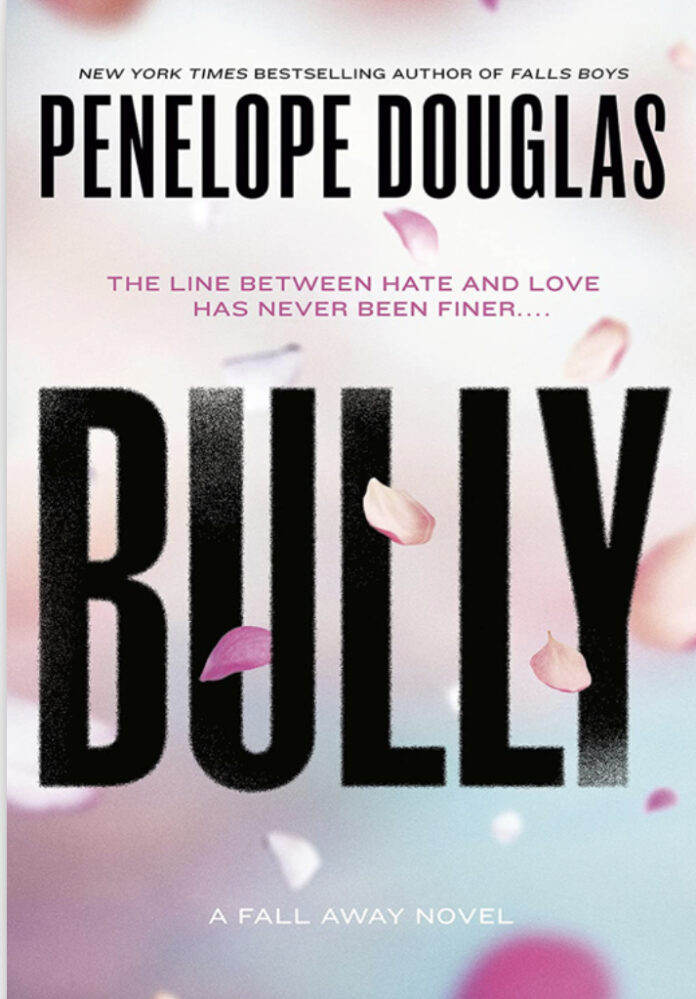In the realm of contemporary young adult fiction,Penelope Douglas’s Bully has sparked conversations that ripple far beyond its pages. With its intense emotional landscape and complex character dynamics, the novel invites readers too confront uncomfortable truths about desire, power, and personal boundaries. This review aims to unpack the layered narrative of Bully, exploring how douglas weaves conflict and vulnerability into a thought-provoking story that challenges as much as it entertains. Through a careful examination, we delve into the nuances that make this book both compelling and contentious, offering insights without succumbing to judgment.
The intricate Exploration of Desire and Power Dynamics That Drives the Narrative Forward
At the heart of Bully lies a complex interplay of desire and control, weaving a narrative that is as unsettling as it is indeed compelling. The characters’ interactions are charged with tension, revealing how power can manifest in subtle manipulations and overt confrontations alike. Rather than resorting to simplistic portrayals of good versus bad, Penelope Douglas crafts a nuanced landscape where vulnerability and strength intersect, challenging readers to reconsider assumptions about domination and submission.
Douglas masterfully uses this tension to propel the story forward, allowing moments of tenderness to emerge amidst the chaos of conflict.The protagonists’ evolving relationship is marked by unexpected shifts in power-sometimes one holds the upper hand, only for the balance to tip back as emotional barriers crumble. This dynamic is echoed throughout the narrative through:
- Intense dialog that reveals hidden motives
- Subtle gestures laden with unspoken emotion
- Conflicts that serve as catalysts for character growth
| Element | Impact on Power Dynamics |
|---|---|
| Secrets | Create leverage and distrust |
| Apologies | momentarily shift emotional control |
| Physical proximity | Blurs boundaries between hostility and desire |
How Conflict Shapes Character Development and Sparks Emotional Intensity Throughout the Story
In Bully, the intricate dance of conflict doesn’t just propel the plot-it serves as a crucible for character transformation.The tumultuous interactions between Tate and Jared are laced with layers of tension that reveal vulnerabilities, buried desires, and unspoken pains. Through their clashes, Penelope Douglas expertly crafts a *dynamic evolution*, where characters are continuously tested and reshaped. This perpetual friction exposes the raw, frequently enough uncomfortable facets of human emotion, making each character’s journey both relatable and intensely compelling.
The emotional intensity is further amplified by how conflict operates on multiple levels throughout the narrative. From sharp, biting exchanges to moments charged with longing beneath the surface, these struggles function as catalysts that drive internal and interpersonal change. Consider the following breakdown of conflict types and their narrative impact:
| Conflict Type | Character Impact | Emotional Effect |
|---|---|---|
| External (e.g.,bullying,social pressure) | Forces characters to confront fears and biases | heightens tension,creates suspense |
| Internal (e.g., self-doubt, moral dilemmas) | Encourages introspection and growth | Invokes empathy and vulnerability |
| Relational (e.g., conflicts between characters) | Challenges loyalties and builds complex dynamics | Ignites passion and emotional depth |
Through this layered portrayal, Bully exemplifies how well-woven conflict acts as more than mere plot mechanics-it is indeed the heartbeat that nourishes character depth and emotional resonance throughout the story.
Balancing Dark Themes with Moments of Vulnerability to Create a Rich Emotional Landscape
Penelope Douglas’s narrative masterfully intertwines the intensity of darker emotional currents with carefully placed moments of vulnerability, enriching the reader’s experience with a complex emotional texture. While the story confronts difficult themes such as tension and conflict head-on, it also carves out spaces where characters reveal their softer, more human sides-moments that invite empathy and understanding rather than judgment. These brief yet poignant respites create a compelling ebb and flow, allowing darkness and light to coexist and amplify each other rather than compete.
Consider the intentional pacing Douglas employs, where explosive confrontations are balanced by intimate breakthroughs. The tension isn’t relentless; instead, it’s tempered with glimpses of tenderness and self-reflection, making each encounter resonate more deeply. This pacing not only challenges the reader but also humanizes the characters, making their struggles and growth feel authentic and earned.
| dark Themes | Moments of vulnerability |
|---|---|
| Conflict & Misunderstanding | Confession & Apology |
| Jealousy & Resentment | Forgiveness & Healing |
| Power Struggles | Trust-Building |
| Isolation | Connection & Support |
- Raw emotional honesty: characters peel back their defenses, revealing hidden fears and desires.
- Strategic pacing: Moments of vulnerability break up the intensity, making the story’s darker elements more impactful.
- Emotional complexity: The interplay between darkness and light adds layers to character development and plot progression.
The Role of Setting in Underscoring the Tension and Atmosphere Within the Novel
Douglas masterfully crafts a setting that acts almost as a silent character, intensifying the emotional stakes and enveloping readers in a world brimming with unease and longing.The high school corridors and the small-town backdrop are not merely physical spaces but arenas where power dynamics and social hierarchies collide.The juxtaposition of familiar, mundane environments with the charged psychological landscape of the characters creates a palpable tension. In Bully, every scene-whether it’s a crowded hallway or a secluded spot by the lake-serves as a pressure cooker for simmering conflicts, secrets, and desires to unfold.
- Claustrophobic interiors: Amplifying the protagonist’s feelings of entrapment and vulnerability
- Contrasting outdoor spaces: Offering moments of fragile reprieve and emotional confrontation
- Symbolic landmarks: Such as the lake and school auditorium acting as stages for pivotal turning points
Below is a simplified overview highlighting how specific settings correspond with the emotional trajectory of the narrative and key themes:
| Setting | Emotional Impact | Narrative Function |
|---|---|---|
| School Hallways | Heightened Anxiety and Social Pressure | Scene for bullying and confrontations |
| Protagonist’s Bedroom | Introspection and Vulnerability | Private reflections and emotional revelations |
| Lake Area | Ambiguous Safety and Intimacy | Moments of vulnerability and connection |
| Auditorium | Dramatic Climax and Exposure | Public confrontation and resolution |
Analyzing the Dialogue That Captures Complex Relationships and unspoken Emotional Underpinnings
Penelope Douglas masterfully crafts dialogue that transcends mere conversation, serving instead as an intricate map to the tangled emotions her characters harbor. Each exchange is laden with subtext, often revealing more in what is left unsaid than in spoken words. The tension and vulnerability between the protagonists simmer beneath the surface, creating an atmosphere where desire and conflict coexist in delicate equilibrium. Douglas’s dialogue employs ellipses, abrupt stops, and charged silences that mimic real emotional hesitations, allowing readers to feel the weight of unspoken thoughts and the fear of confronting painful truths.
Consider how the characters’ verbal sparring unfolds as a subtle dance of power and intimacy. This dynamic is captured through:
- Sharp retorts masking hidden affections
- Carefully chosen words that both protect and provoke
- Understated moments revealing vulnerability
Such complexities highlight the push and pull intrinsic to their relationship. The following table illustrates how dialogue cues echo the emotional shifts throughout pivotal scenes:
| Scene | Dialogue Example | Emotional Underpinning |
|---|---|---|
| Confrontation in hallway | “maybe you’re the bully.” | Defensiveness & hidden guilt |
| Late-night confession | “I don’t want to hurt you.” | Fear & longing |
| Silent aftermath | (No words, just a glance) | Unspoken tension & unresolved desire |
the Subtle Use of Symbolism to enhance reader Engagement and Deepen Thematic Resonance
Within Bully, symbolism operates like an undercurrent, weaving quietly throughout the narrative to deliver a more immersive reading experience.Penelope Douglas often employs everyday objects and recurring motifs-like the contrast between light and shadow, the symbolic weight of music, or the use of physical spaces-to mirror the emotional dynamics between characters. These elements don’t just serve as background details; rather, they invite readers to peel back layers of meaning, transforming seemingly simple scenes into nuanced reflections of desire and internal conflict. As an example, the motif of broken glass subtly echoes the fragility and turmoil underpinning the protagonists’ interactions, while the repeated presence of handwritten notes underscores themes of vulnerability and unspoken truths.
Such symbolism enhances engagement by prompting readers to actively interpret and connect with the characters’ journeys on a deeper level.This enriches the thematic texture without overwhelming the plot. Below is a table that illustrates key symbols in Bully and their implications within the story, showing how Douglas masterfully balances subtlety with importance:
| Symbol | Meaning | Focus Area |
|---|---|---|
| Broken Glass | Emotional Shards & Vulnerability | Conflict & Fragility |
| Music | Unspoken connection & Mood Shifts | Desire & Tension |
| Handwritten Notes | Secrets & Yearning | Communication Barriers |
| Shadows / Light | Duality & Hidden Truths | Internal Struggle |
- Subtle symbolic cues encourage readers to linger and reflect, deepening emotional involvement.
- Recurring motifs create thematic coherence without heavy exposition.
- Symbolism’s restraint maintains narrative flow,allowing internal and external conflicts to organically unfold.
How Pacing Influences Reader Investment and effectively Builds Suspense in the Plot
Pacing in Bully is a masterful dance, oscillating between moments of intense emotional turmoil and quieter, introspective beats that allow readers to breathe and reflect. penelope Douglas expertly manipulates tempo to ensure that every revelation and conflict lands with maximum impact, keeping readers tethered to the narrative.The strategic slowing down during character interactions invites deeper emotional engagement, while swift shifts into confrontations escalate tension, propelling the story forward. This deliberate rhythm ensures that the story never stagnates, maintaining a magnetic pull that transforms casual interest into genuine investment.
Douglas’s approach to pacing is also integral to building suspense, as it cultivates anticipation without immediate resolution. The ebb and flow often mirror the internal conflicts of the characters, creating a layered suspense that operates both externally within the plot and internally within their psyches. Below is a simple breakdown of how pacing elements correlate with reader experience:
| pacing Element | Effect on reader | Example in Bully |
|---|---|---|
| Slow, tension-building dialogue | Heightens anticipation, deepens character understanding | prolonged conversations revealing hidden motivations |
| Rapid conflict escalation | Increases emotional stakes, drives urgency | Unexpected confrontations between protagonists |
| Strategic pauses | Allows reflection, amplifies suspense | Silent moments before critical decisions |
Unpacking Moral Ambiguity and Ethical Dilemmas Presented Through Key Character Choices
At the heart of Bully lies a tangled web of decisions that blur the lines between right and wrong, challenging readers to reassess their own judgments. Penelope Douglas crafts characters whose choices are neither wholly good nor entirely evil, but instead reflect the complexities of human nature. As a notable example, the protagonist’s tendency to engage in morally questionable actions – such as calculated manipulation or withholding truths – demands an introspective look at the motivations behind such behavior. These moments push readers to consider: can flawed choices be understood outside of personal circumstances, or are some lines simply uncrossable?
Through these intricate character arcs, the novel presents ethical dilemmas that resist easy resolutions.
- forgiveness vs. Justice: Who deserves redemption, and what does true accountability entail?
- Protection vs. Harm: When is deception justified to shield loved ones?
- Power Dynamics: How do coercion and vulnerability reshape consent?
These questions resonate throughout the narrative, reflecting not only teenage turmoil but broader societal debates. The ambiguity surrounding the characters’ actions mirrors real life,where decisions often reside in shades of gray rather than black and white. The following table summarizes key choices and their ethical tensions:
| Character Choice | Ethical Tension | Potential Consequence |
|---|---|---|
| Withholding Truth | Honesty vs.Protection | Damaged Trust |
| Manipulative behavior | Control vs. Consent | Emotional Turmoil |
| Seeking Revenge | Justice vs. Vengeance | Perpetuated Conflict |
The Impact of Secondary Characters in Enriching the Main Conflict and Adding narrative Depth
In Bully, secondary characters serve as essential catalysts that elevate the emotional stakes and intricacies of the central conflict. Their presence disrupts the protagonists’ world in varied ways-sometimes as obstacles,other times as sources of unexpected support. These figures, tho peripheral in screen time, are far from superficial; they embody societal pressures, personal biases, and hidden desires that challenge the main characters’ decisions. This intricate web of relationships enriches the narrative, allowing readers to witness how external influences complicate internal struggles.
Consider the following roles that secondary characters assume throughout the novel:
- Foils: Characters who highlight contrasting traits,thereby sharpening the protagonist’s complexities.
- Confidantes: Trusted figures who reveal deeper emotional layers through intimate conversations.
- Antagonistic Forces: Individuals who escalate tension, either through direct conflict or subtle manipulation.
| Secondary role | Function | Impact on Narrative |
|---|---|---|
| Foil | Contrast protagonist traits | Amplifies internal conflict |
| Confidante | Emotional sounding board | Deepens character insight |
| Antagonist | Create obstacles | Heightens dramatic tension |
By weaving these archetypes seamlessly into the story’s fabric, Douglas invites readers to not only focus on the protagonists’ journey but also to appreciate the subtle nuances occurring on the periphery. These narrative layers ensure the conflict remains dynamic, compelling, and authentic, ultimately transforming what might have been a straightforward romance into a richly textured exploration of desire and power.
Exploring Narrative voice and Its Effectiveness in Conveying Internal Struggles and Desires
Penelope Douglas masterfully adopts a narrative voice that delves deep into the psyche of her protagonists, capturing their internal conflicts with both subtlety and raw intensity. The first-person perspective immerses readers in a whirlwind of emotions, making it unachievable to dissociate from the characters’ desires and doubts.This closeness allows for an intimate exploration of the complexity of their feelings-balancing vulnerability with defensiveness, longing with resistance. The voice isn’t just a storytelling tool; it becomes a lens through which readers experience the nuanced dance of attraction and hostility that defines their interactions.
What makes the narrative voice in Bully notably effective is its ability to oscillate between tension and tenderness without losing authenticity. Through this voice, Douglas highlights key emotional undercurrents such as:
- Yearning masked as aggression
- Fear of rejection beneath bravado
- Conflicted self-perception and growth
This dynamic portrayal prevents the story from falling into cliché and invites readers to unpack the layers of each character. The shifts in tone-from sarcastic to sincere-mirror the protagonists’ evolving internal landscapes, making their conflicts and desires feel palpable and real.
| Aspect | Effect on Reader |
|---|---|
| First-person intimate narration | Heightens emotional connection |
| Conflicted narrative tone | Showcases complexity of feelings |
| Vivid internal dialogue | Reveals hidden desires and fears |
Recommendations for Readers Who Appreciate Thought-Provoking Romance with intense Emotional Stakes
If you’re seeking recommendations, here are some must-reads that echo the electrifying tension and intricate emotional depth found in Penelope Douglas’s work:
- “The Maddest Obsession” by Danielle Lori: A dark, addictive romance with rich emotional turmoil and fierce possessiveness.
- “Archer’s Voice” by Mia Sheridan: A tender yet heartrending story about overcoming trauma through love and understanding.
- “Crow” by A. Zavarelli: Gritty and raw, this novel weaves danger and desire into a compelling, tension-filled tale.
- “Punk 57” by Penelope Douglas: A bittersweet exploration of identity, communication, and the scars we hide.
| Book | Emotional Tone | Key Element |
|---|---|---|
| The Maddest Obsession | Intense & Dark | Possessive love |
| Archer’s Voice | Tender & Healing | Overcoming Trauma |
| Crow | Raw & Gritty | Danger & Desire |
| Punk 57 | Bittersweet & Complex | Identity & Communication |
Considerations on Triggers and Content Warnings for Sensitive Themes Within the Story
Penelope Douglas’s Bully doesn’t shy away from diving into complex and sometimes uncomfortable emotional terrain. While the story’s layered narrative captures themes of desire and conflict with intensity, it is indeed critically important for readers to be aware of the sensitive subjects woven into the plot. These include emotional manipulation, bullying, and elements of non-consensual situations that may be triggering for some audiences. Recognizing these components upfront allows for a more mindful reading experience and creates space for reflection rather than discomfort.Trigger awareness empowers readers to engage with the narrative on their own terms, ensuring that the impact of the story remains thoughtful rather than distressing.
- emotional Turmoil: The protagonists navigate intense feelings of anger, obsession, and vulnerability.
- Power Dynamics: The imbalance of control and consent is a recurring tension throughout the story.
- Bullying and Social Isolation: These elements underpin manny character motivations and conflicts.
For readers seeking transparency, here’s a concise overview of content warnings to consider before delving into the book:
| Theme | Potential Impact |
|---|---|
| Bullying | Raises anxiety or distress around social exclusion |
| Non-consensual interactions | May trigger past trauma or discomfort |
| Emotional abuse | Highlights manipulative behaviors and psychological distress |
By offering these considerations, the narrative doesn’t lose its power but instead invites a more intentional reading.It challenges audiences to engage critically with the themes and to foster discussions about how complex relationships and conflicts are portrayed in contemporary storytelling.
Comparing Bully to Other Works Within the Romance and Dark Contemporary Genres for Context
Penelope Douglas’s Bully occupies a distinctive space in both the romance and dark contemporary genres, blending elements that are frequently enough explored separately. Unlike typical contemporary romances that focus on lighthearted or uplifting narratives, bully dives into the complexities of emotional turmoil and blurred moral lines. This distinction places it alongside works that tackle the gravity of trauma and redemption but with an intense romantic tension that refuses to shy away from discomfort. Where many romance novels might hesitate to delve deeply into the consequences of toxic behaviors or unhealthy relationships, Bully confronts these themes head-on, making it a notable outlier that challenges readers to question traditional notions of heroism and love.
When compared with other dark contemporary novels,Bully shares the exploration of flawed characters and messy dynamics,yet it remains unique in how it weaves a slow-burning desire into its narrative,rather than relying solely on angst or despair. Here’s a brief comparison of Bully with other notable works in the genres:
| Title | Genre | Theme Focus | Romantic Tone |
|---|---|---|---|
| Bully | Romance / Dark Contemporary | Redemption, Blurred Morality | Intense, Slow Burn |
| Tangled by Emma Chase | Romantic Comedy | Lighthearted, Humor | Playful, Uplifting |
| The Dark Duet by CJ Roberts | Dark Romance | Trauma, Survival | Angsty, Raw |
| Verity by Colleen Hoover | Psychological Thriller / Romance | Suspense, Secrets | Dark, Twisted |
- Complex Protagonists: Bully shares a focus on deeply flawed, multidimensional characters.
- Uncomfortable Themes: Similar to dark contemporary works, it willingly explores emotional discomfort and conflict.
- Romantic Ambiguity: The romance is layered with tension and moral uncertainty, setting it apart from straightforward love stories.
Penelope Douglas as an Author Her Unique Style and Contributions to Contemporary Romance Literature
Penelope Douglas has carved a distinctive niche in contemporary romance by masterfully blending raw emotion with complex character dynamics. Her narrative style is marked by intense relational conflicts and layered emotional landscapes, setting her apart from traditional romance tropes. Douglas doesn’t shy away from exploring the darker, more complex sides of desire, frequently enough intertwining themes of vulnerability and power in ways that challenge and engage readers. The depth she brings to her protagonists-flawed yet deeply human-transforms her stories from mere love tales into profound explorations of growth and redemption.
Her contribution to the genre is further underscored by her innovative approach to pacing and tension. Through a blend of sharp dialogue, evocative imagery, and carefully crafted suspense, Douglas sustains an electric and charged atmosphere throughout her work. Below is a simple overview of some key elements that characterize her writing style and influence:
| Element | Description |
|---|---|
| Character Complexity | Multi-dimensional protagonists with realistic flaws |
| Thematic Boldness | Exploration of taboo and emotional conflict |
| Emotional intensity | Heightened feelings creating palpable tension |
| Dialogue | Witty, sharp, and frequently enough charged with subtext |
| Plot Structure | Slow burn with escalating stakes and payoff |
- Relatable imperfection: Characters who mirror real human struggles.
- Raw storytelling: Candid portrayal of emotional and social complexities.
- Engaging conflicts: Dynamics that push characters toward growth.
Bully by Penelope Douglas is a complex exploration of desire tangled with conflict-an emotional landscape that challenges readers to confront uncomfortable truths beneath the surface of its characters’ interactions. While it may not be a perfect journey for everyone, its raw intensity and unflinching portrayal of messy relationships offer fertile ground for reflection. Whether you find yourself drawn into its storm or pushed away by its turbulence, Bully undoubtedly leaves a lasting impression worth unpacking long after the final page is turned.











